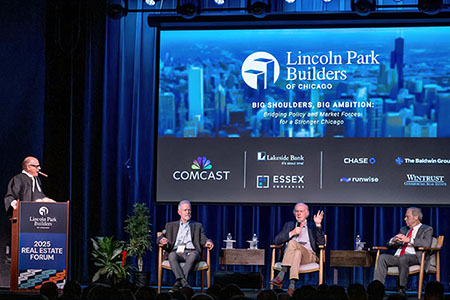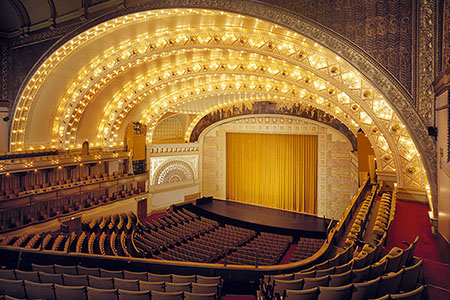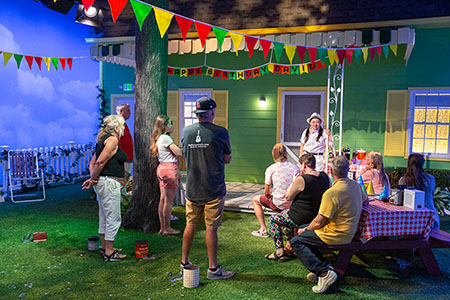
With a 36-story apartment tower set to rise in Old Town, and the city approving more high-rises, residents call for vigilance to protect their neighborhood’s historic integrity.
(Above) Buildings in the Old Town Historic District. Photo by Don DeBat. May 12, 2025 – Back in the 1970s, creating historic landmark architectural districts was the rage in Chicago. The idea was based on the premise that historic landmark districts promoted gentrification, which solidified neighborhoods, increased property values, and stopped or at least slowed urban blight. In Chicago during the 1950s-and-1960s era of racial change, block-busting, red-lining, and panic-peddling were pushed by unscrupulous realty agents, and many white homeowners fled the city for the suburbs. However, the pendulum started swinging back in the 1970s. The “back-to-the-city” movement lured young, restoration-minded families back to the inner city, especially in urban renewal neighborhoods such as Old Town and Lincoln Park. Hundreds of vintage, historic 1880s buildings were preserved, and an architectural treasure trove gradually developed. The charming Old Town Historic District with 523 magnificently restored Victorian buildings – some museum-quality – was born in 1977. Today, the Old Town Triangle, bounded roughly by North Avenue, Wells Street, Lincoln Avenue, Clark Street, and a string of side streets on the west, is home to the annual Old Town Art Fair and Garden Walk, and guided architectural tours. Another classic example of preservation can be found on the 1500 block of West Jackson Boulevard, which was designated a landmark district in the late 1970s. The Victorian row house block was guided through the landmark process by urbanologist Phillip Krone and rehab preservationist William Lavicka. It still stands as a monument to urban preservation on the Near West Side.
Today, this writer proudly owns a Victorian building in the Old Town Historic District and once resided in a historic rowhouse on the 1500 block of West Jackson Boulevard. As an urban pioneer and bungalow owner in the mid-1970s, I also was deeply involved in the planning and landmarking of the Irving Park Villa neighborhood, a triangle bounded by Addison Street, Avondale, and Pulaski Road on the Northwest Side. Unfortunately, in late 2024 the battle against high-rises in Old Town was lost. Residents and building owners in the historic district could not prevent approval of a rental tower at North Avenue & Wells Street. The Chicago City Council recently approved Old Town Canvas, a 36-story, 349-apartment high-rise at 1600 North LaSalle Drive after the developer, Chicago-based Fern Hill Company, reduced the height of the building. Earlier, opponents of Old Town Canvas formed a coalition, citing concerns about its size, public safety, and probable impact on traffic.
Old Town Friends for Responsible Development (OTFRD), a grassroots coalition comprising more than 1,500 residents of Old Town, Gold Coast, and Lincoln Park, including condominium boards and businesses, argued that the proposed building, with its large number of rental apartment units, is excessive for the neighborhood. The OTFRD says the massive multifamily project would be too large and disruptive. In addition, they are seeking assurances regarding mitigated traffic and disruption to local businesses during construction. Stiff opposition to high-rise development What is more worrisome is the project also includes the rezoning of Piper’s Alley, Moody Church, and neighboring gas stations. Those properties allegedly would not be allowed to have residential units. However, there is no prohibition on Fern Hill or any other developer from changing the later phases of the planned development in the future. Eighty-four percent of respondents to a survey by the Old Town Triangle Association (OTTA) expressed opposition to Fern Hill’s high-rise project density and rezoning application, according to OTTA president Raymond Clark. Launched in 1948, the respected neighborhood organization fought in 1977 for Old Town to be designated a Historic Landmark District, and in 1984 it was listed on the National Register of Historic Places.
Diane Gonzalas, a preservationist and architectural historian, who was involved in the landmarking of the Old Town Triangle, said: “We don’t want Old Town to become Sandburg Village.” As a Victorian building property owner, who annually displays his garden on the Old Town Garden Walk, this writer worries about more mammoth high-rises casting shadows over his flowering crabapple trees, gurgling waterfall, and reflecting pool crowned by a statue of Rebecca at the Well. In protest, for the first time in two decades, my garden will not be on the 2025 walk. Other North Side lakefront landmark districts soon may also be threatened by nearby rezoning that usher in high-rise encroachment. Let’s hope property owners in such landmark areas as Arlington-Deming, Armitage-Halsted, Burling Row House, McCormick Row House, and Mid-North District, which borders Lincoln Park, remain on full-time high-rise alert. Further north, the upzoning of Broadway Avenue between Montrose Avenue and Devon Avenue in Edgewater and Uptown also needs a high-rise watch, as the Chicago Department of Planning & Development wants to change zoning to bring in more affordable housing and density to these areas. John Holden, president of the Edgewater Historical Society, noted that the zoning proposal contradicts the downzoning of the west side of Broadway that Edgewater neighbors fought for about 25 years ago. The west side of Broadway backs up to two-flats and three-flats and single-family homes, Holden said. And the landmark historic Dover Street District and the Uptown Square District are not far away. More info: Old Town Triangle Association |
















